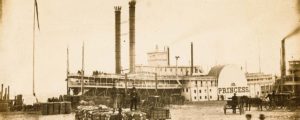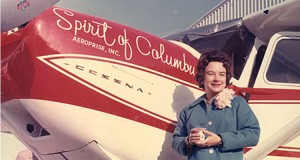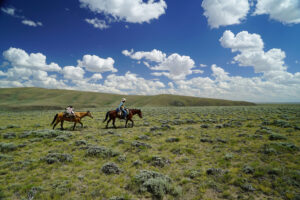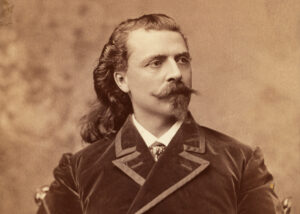The 1906 bout pitted the ‘Old Master’ against the ‘Durable Dane’
A massive crowd descended on Goldfield, Nevada, on Labor Day 1906. People arrived by train from as far away as Maine and Massachusetts, while the region’s miners reached Goldfield by trudging the desert for miles. Such a swell in population was unusual, as Goldfield’s climate was so awful one visitor had dubbed the town “Dante’s inferno with the lid off.” The enormous gathering was the culmination of George Lewis “Tex” Rickard’s hard work. He believed that hosting such a championship bout would improve Goldfield’s bleak image.
A 1902 gold strike had transformed Goldfield into Nevada’s largest town, creating the biggest buzz in Nevada since the 1859 discovery of the Comstock Lode. Rickard, a Missouri-born entrepreneur who, according to some sources, picked up the nickname “Tex” after living briefly in Henrietta, Texas, was one of the treasure seekers who had landed in the newly thriving district. Operator of the Northern saloon and gambling hall, he had become one of Goldfield’s top businessmen, reportedly even hiring Virgil Earp of Tombstone fame as pit boss. But Rickard agreed with the town fathers that Goldfield would continue to thrive only if it moved beyond the usual boomtown staples of brothels and opium dens.
The men floated various ideas, including a camel racetrack and a manmade lake of beer. Rickard understood the allure of prizefighting. He’d previously owned a saloon in the Yukon, where aging bare-knuckle star Frank Slavin sometimes fought for the customers’ entertainment. Rickard reminded anyone who would listen that men still reminisced about the September 1892 New Orleans bout between John L. Sullivan and James J. “Gentleman Jim” Corbett. In August 1906, along with 27 other businessmen, Rickard formed the Goldfield Athletic Club. They planned a match on the scale of Sullivan-Corbett in hopes of attracting investors to buy mining stock.
Some biographers claim Rickard became the bout’s promoter only because his partners were glad to finance the event but dreaded doing the work. Rickard also likely understood that promoting such a fight might be a path to fame. Regardless of how he stepped into the role, Rickard soon attracted the attention of two great fighting men—lightweight champion Joe Gans and a man known in the newspapers as Battling Nelson.
Nelson, prophetically named Oscar Matthew Battling Nelson by his father, was born in Copenhagen but raised in Chicago. Dubbed the “Durable Dane” by sportswriters, Nelson was allegedly the model for Jack London’s novel The Abysmal Brute. Gans, a crafty fighter from Baltimore known as the “Old Master,” was the first black American to win a world boxing title. Both were interested in the whopping $30,000 purse (it would grow to $32,000 in gold) offered by the Goldfield group. Nelson’s manager, Billy Nolan, laid out several stipulations, including a $20,000 payment to Nelson, win or lose. The fight would also be a “finish fight,” decided only when one of the men dropped or quit, a scheme thought to favor the hardheaded Nelson. Inundated by gambling debts, Gans agreed to Nolan’s demands. When the news broke that Rickard had secured the fight for Goldfield, mine owners blasted off three loads of dynamite in celebration.
Part of the hoopla was that a black champion was facing a white challenger. Indeed, Nelson laid claim to the “white lightweight championship,” a distinction not unusual in the 1900s. Rickard thus chose to present the fight not as a mere sporting contest, but as a “battle of the century,” with heroes, villains and a well-defined racial plotline. But if Rickard sought a battle of the races, he may have been surprised to learn that Gans drew the admiration of even the most bigoted of whites. The champion’s mere arrival in Goldfield was an event.“Gans was met by carriages and automobiles,” reported The Salt Lake Tribune, “and a great crowd.” Meanwhile, Nelson appeared moody. He made things worse for himself by working a spell on the Goldfield women, declaring one day per week at his training quarters as “Ladies’ Day.” Without trying too hard, Rickard had his hero (Gans) and his heel (Nelson).
Rickard then brought a photographer to the John S. Cook & Co. Bank, where the $30,000 purse was on display in stacks of $20 gold pieces. It was the largest amount ever guaranteed to two fighters up to that time. The Cook & Co. photo, in which Rickard poses beside the 1,500 coins, appeared in newspapers around the country. The Police Gazette anointed Rickard the “new fight king.”
Local men worked frantically to erect an 8,000-seat open-air arena on the edge of town. By the time the last nail was hammered into the last plank, Goldfield had switched from gold fever to boxing fever. Tickets were priced from $5 to $25, with a higher-priced section reserved for local dignitaries and politicians. The printed programs contained more information about mining stock than the fight. Hotels were overbooked, so fight fans pitched tents on the street. Con artists roamed the area looking for marks. Rumors of a fixed fight were soon quashed. On September 3 the region locked down for the fight. Stores closed, mining equipment was silenced. Although folklore has Gans and Nelson fighting under a blazing sun in 100-degree heat, contemporary accounts describe “the brightest and most perfect September day,” as if Rickard had even managed the weather.
Boxing historians regard the bout as one of the greatest and bloodiest in the history of prizefighting. Gans fought in his usual artistic manner—“the Paderewski of the boxing glove,” one reporter called him, after the great composer— while Nelson butted, elbowed and even kicked. Finally, after nearly three hours of fighting, Nelson opened the 42nd round by punching Gans repeatedly below the belt. “I never saw such agony on a human countenance as was on Gans’ when he went down,” wrote Joel L. Priest of The Salt Lake Herald. “His face was gray and drawn, his mouth was open, and in his eyes was the look one sees sometimes in the eyes of an animal that has been mortally wounded.” Referee George Siler immediately disqualified Nelson, who protested. The San Francisco Call noted that as Gans was carried back to his dressing room, he “was followed by hundreds who were anxious to shake his hand and tell him they thought he was the greatest fighter in the age.”
The next day Gans rode around town thanking the people for their kind support. He was in good spirits, having made extra money by placing side bets on himself. Regarding Nelson, The Minneapolis Journal reported,“There are several thousand pretty tough citizens of Goldfield who would like to escort him out of town on a rail, or following a custom of the desert, stake him out on the alkali with a rattlesnake for an interesting companion.” But Nelson would fight Gans twice more, winning both times by knockout. Gans, showing signs of the tuberculosis that would kill him in 1910, was never the same after the Goldfield bout.
Although marred by a foul ending, the bout had been a grand success. The arena was full, and box office receipts totaled more than $70,000. By the day’s standard it was a smashing achievement.
Goldfield enjoyed another year or so of prosperity, but labor disputes and a decrease in ore production spelled a downturn. By 1910 the population had fallen from 20,000 in 1906 to 4,838. In 1923 a fire devastated the town. Goldfield kept producing gold, but its glory days were over.
As Goldfield’s fortune faded, Rickard went on to promote million-dollar bouts nationwide. His big star was heavyweight champion Jack Dempsey. By the time of Rickard’s death in 1929, at age 59, he had promoted the first boxing show at Yankee Stadium, built the Boston Garden and founded the New York Rangers hockey team. In his 1906 promotion to sell goldmining stock, Rickard had inadvertently ushered in the golden age of boxing in America and laid the foundation for all sports promotion to come.
Originally published in the December 2013 issue of Wild West. To subscribe, click here.




